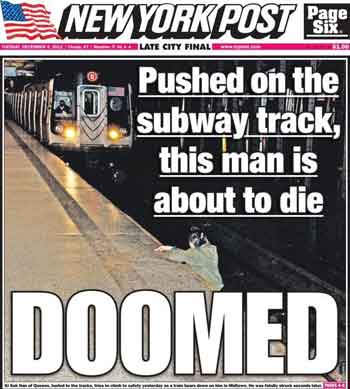 |
|
Why didn't the photographer help? Why did the newspaper publish the photo? |
|
The man in the picture has his back to the camera. He's desperately clawing at a subway platform, looking right at the train that's bearing down on him as he stands on the tracks. It's a terrifying, heart-wrenching image, and it's generating a lot of criticism for the newspaper that used it on its front page -- the salty, sensational New York Post. Why didn't the photographer help? Why did the newspaper publish the photo? "NY Post should be ashamed of its misuse of humanity for its cover photo of a man about to be killed by a subway train," one person wrote on Twitter. "When does cruelty end." "Snuff porn," another user labeled it. A freelance photographer captured the image Monday after someone shoved the man, 58-year-old Ki-Suck Han, from a subway platform near Times Square. Seconds after photographer R. Umar Abbasi captured the images, the train fatally struck Ki. He died at a New York Hospital, leaving behind a wife and daughter. "Doomed," the headline read. "Pushed on the subway track, this man is about to die." In its story on the incident Tuesday, the Post reported Abbasi was waiting on the platform when he saw the man fall onto the tracks. He said he ran towards the oncoming train, firing his camera's flash to warn the driver. "I just started running, running, hoping that the driver could see my flash," the newspaper quoted him as saying. "In that moment, I just wanted to warn the train -- to try and save a life," the Post quoted him as saying. Some critics, however, questioned Abbasi's motives. One Twitter user questioned why someones first instinct would be not to help the man, but instead to "snap a photo of him about to die and sell it to the NY Post." The Post declined to comment. Media observers wondered Tuesday if the newspaper had gone too far this time. (Read by Brian Salter. Brian Salter is a journalist at the China Daily Website.) (Agencies) |
照片中的這名男子背對(duì)著鏡頭,絕望地用手抓住地鐵站臺(tái),站在鐵軌上,眼睛直視沖他駛來(lái)的地鐵列車(chē)。 這一場(chǎng)景令人恐懼,也讓人揪心。報(bào)道辛辣而又愛(ài)嘩眾取寵的《紐約郵報(bào)》由于在頭版刊登了這一照片,也引發(fā)了人們對(duì)它的批評(píng)。 為什么攝影師不過(guò)去幫忙?為什么這家報(bào)紙刊登這張照片? 有人在推特上寫(xiě)道:“《紐約郵報(bào)》在頭版刊登了一張一名乘客即將被地鐵列車(chē)碾碎的照片,它應(yīng)為濫用人性而感到羞恥。這種殘酷的行為何時(shí)才能終止?” 另一名用戶寫(xiě)道:“太惡心了。” 本周一,58歲的韓基石在紐約時(shí)代廣場(chǎng)附近的一處地鐵站臺(tái)上被人推了下去,自由攝影師奧馬爾?阿巴西拍下這一場(chǎng)景。 攝影師R?奧馬爾?阿巴西拍下照片幾秒鐘后,地鐵列車(chē)撞向韓基石。他在紐約一家醫(yī)院去世,身后留下妻子和女兒。 標(biāo)題寫(xiě)道:沒(méi)救了。這個(gè)人被推下站臺(tái),就快死了。 在本周二關(guān)于這起事件的報(bào)道中,《紐約郵報(bào)》報(bào)道說(shuō),當(dāng)時(shí)阿巴西正在地鐵站臺(tái)上,他看到一名男子掉落了下去。他說(shuō)他跑向駛來(lái)的列車(chē),試圖用照相機(jī)的閃光燈提醒列車(chē)司機(jī)注意。 報(bào)紙?jiān)脑捳f(shuō):“我開(kāi)始向那里跑去,希望司機(jī)能看見(jiàn)閃光”。 “當(dāng)時(shí),我只是想提醒列車(chē),試圖去挽救他的性命。” 但一些批評(píng)人士對(duì)他的動(dòng)機(jī)提出質(zhì)疑。 一名推特用戶質(zhì)疑說(shuō),為什么有些人的第一反應(yīng)不是救人,而是“拍下這名將死之人的照片賣(mài)給《紐約郵報(bào)》?” 《紐約郵報(bào)》拒絕對(duì)此發(fā)表評(píng)論。媒體觀察人士本周二也開(kāi)始提出質(zhì)疑,認(rèn)為這次該報(bào)做得太過(guò)分。 相關(guān)閱讀 夢(mèng)露經(jīng)典“地鐵裙”被拍賣(mài) 價(jià)值460萬(wàn)美元 (中國(guó)日?qǐng)?bào)網(wǎng)英語(yǔ)點(diǎn)津 Julie 編輯:陳丹妮) |
|
Vocabulary: bear down on: 沖向 go too far: 走得太遠(yuǎn),做的過(guò)火 |
